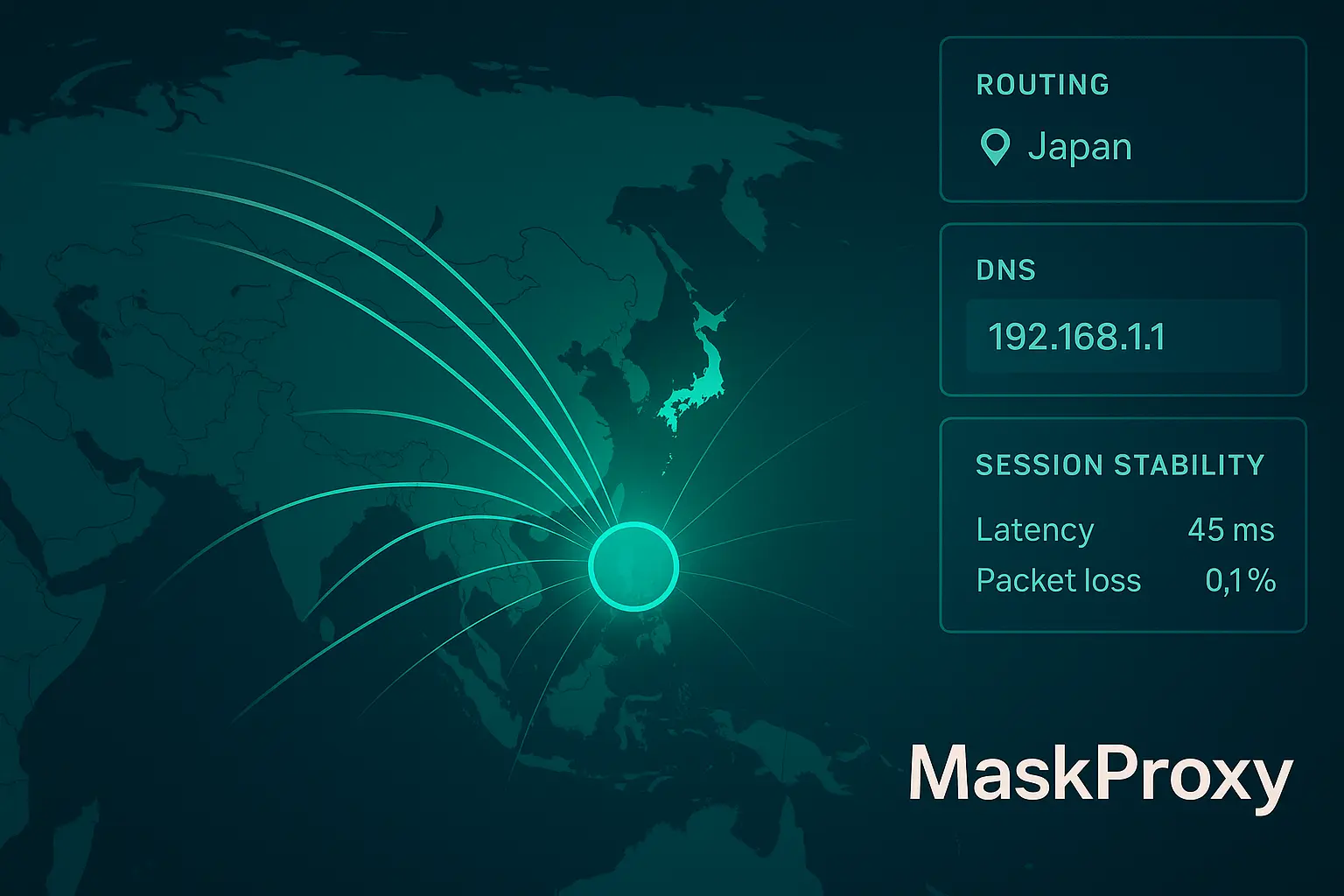Optimizing Japan Proxy Server Routing for Modern Cross-Border Operations

Teams running Japan-facing automation, ad verification, SEO tests, or localized QA often need dependable routing that maintains a stable Japanese identity. Using a japan proxy server helps ensure platforms interpret your traffic as domestic, improving trust, lowering false-positive detection, and supporting long-running workflows. Many operators pair this routing layer with a regional Japan proxy endpoint to strengthen stability and visibility across tasks, especially when scaling cross-border operations.
Why Businesses Depend on Reliable Japan Exit Nodes
A strong Japanese egress point helps ensure local identity remains consistent as apps verify location, device profile, and connection patterns. Stability matters because many ad networks and commerce platforms use regional heuristics to flag unusual sessions.
MaskProxy customers often use Japanese routes to preview mobile landing pages, validate organic rankings, or check localized pricing flows. A reliable node reduces session resets and avoids interruptions that can impact analysis cycles.
Business teams also value predictable behavior. Persistent Japanese presence during tests helps reduce variability, making performance signals easier to interpret across campaigns.
Some users combine Japanese routing with a flexible regional rotating stack to compare behaviors in multiple APAC markets without changing core infrastructure.
When choosing a Japan exit node, teams can follow a simple decision path:
- Use fixed Japanese routes when sessions require long login persistence or repeated account actions.
- Use dynamic Japanese endpoints when testing UI variations, pricing checks, or short-run automation with high concurrency.
This gives operators a predictable method for selecting the right setup without trial and error.
Selecting a Japan Proxy Server Setup That Supports Scale
High-throughput automation or multi-account operations demand a setup that can maintain concurrency without degrading response times. A robust server configuration ensures consistent bandwidth even under burst traffic.
Teams evaluating Japanese endpoints typically consider factors like ASN reputation and stability during peak hours. These influence how platforms classify your traffic and whether throttling occurs.
MaskProxy users often build their routing pipelines around predictable endpoint pools. This helps align workloads with market-specific testing windows and reduces the risk of identity drift.
For cross-border scraping and QA, pairing a fixed tunnel with a reliable Japanese gateway strengthens session continuity for longer test cycles.
A practical evaluation framework many operators use:
- High-volume scraping → prioritize bandwidth and ASN trust.
- App login or ad accounts → choose longer-lived exit IPs.
- Regional SEO checks → prefer endpoints with low DNS drift.
- Short bursts of automated QA → flexible concurrency > static IP stability.
This keeps decision-making consistent across teams.
Maintaining Local Japanese Identity Across Long Sessions
Identity consistency becomes essential during login flows, subscription checks, or regional onboarding sequences. Operators often route both DNS and HTTP traffic directly through the Japanese egress point to avoid mismatches between IP and domain resolution.
When implementing a Japan-based proxy route, teams sometimes use dedicated IPs for long-lived app sessions. This helps avoid micro-changes that could cause re-authentication prompts or trigger risk heuristics.
MaskProxy users running affiliate or ad ops generally test multiple paths to ensure stable attribution. Maintaining clean identity signals across hours or days reduces the likelihood of incomplete conversions.
Ensuring correct timezone, DNS routing, and static egress paths helps reinforce domestic presence throughout the test lifecycle.
Some platforms in Japan apply additional verification layers when DNS or IP signals are inconsistent. If DNS leaks or mixed regions appear, sessions may prompt repeated reauthentication or even temporary lockouts. Teams relying on login-based workloads should avoid any rotation that introduces micro-changes during a running session.
When Dynamic Routing Matters for Multi-Region Testing
Cross-border teams often need to compare Japan-specific flows with Korea, Singapore, or US versions of the same product. A dynamic layer—such as a high-quality rotating proxy workflow—can support these controlled experiments.
Rotating endpoints help teams understand content differences, fraud-prevention thresholds, or region-sensitive interfaces. Combining this with a dedicated Japanese server offers a balanced approach: stability for primary tasks and flexibility for research.
Engineers may rotate only specific tasks while preserving the core Japanese identity for main workloads. This blended approach reduces infrastructure overhead.
Policy routing allows these tests to stay isolated, ensuring no unintended leakage into production traffic.
Dynamic routing is ideal for comparative research but not suitable for:
- long-term identity sessions,
- subscription workflows,
- tasks requiring strict IP persistence.
Using rotation in these cases can trigger risk scoring or disrupt attribution tracking.
Ensuring Stability and Observability in Japanese Traffic Paths
Monitoring latency and packet consistency is essential when maintaining Japan-focused automation. Lower jitter improves reliability for API checks and scheduled testing routines.
Operators frequently log tunnel health, traffic patterns, and DNS responses to detect anomalies early. MaskProxy users often integrate lightweight monitoring to track whether Japanese egress remains stable during regional load shifts.
Look for packet drops or route oscillations, as they can signal upstream congestion. Addressing issues quickly helps maintain consistent performance across work cycles.
Performance observability plays a large role in scaling multi-market operations without compromising session integrity.
If you observe sudden latency spikes or packet irregularities, this may indicate upstream congestion rather than local misconfiguration. Continuing operations under unstable routes increases the chance of incomplete API calls or test failures, so operations teams typically pause traffic and wait for route recovery.
Layering Proxies or Static IP Blocks for High-Fidelity Testing
Some teams require deeper regional authenticity—especially when testing subscription flows, account registration, or payment journeys. Using a static residential proxies layer can help maintain continuity because IPs remain fixed across sessions.
These stable blocks perform well in scenarios where identity should not rotate, such as multi-day QA verification or long-term account operations. When combined with a Japan egress path, the hybrid design yields predictable behavior.
Operators with precise risk tolerances use this layered model to reduce noise in data results. High-fidelity routing ensures tests remain consistent even when platforms perform strict location checks.
Linking stable Japanese endpoints with dedicated addresses helps teams achieve repeatable measurement across different product surfaces.
Teams can apply this simple rule:
- Static residential IPs → best for workflows that must remain unchanged for days.
- Shared or rotating IPs → best for monitoring content variance across markets.
- Hybrid (static + Japanese exit) → best for risk-sensitive actions with multi-day verification cycles.
A dependable Japan routing setup strengthens automation and testing workflows across marketing, QA, and cross-border engineering teams. It improves session durability, enhances identity consistency, and supports clean regional evaluations. Many operators extend their environment with a Japan proxy server route or additional APAC nodes to broaden coverage. As workloads grow, review endpoint quality, policy routing, and identity layers to maintain reliable performance across every regional scenario.




